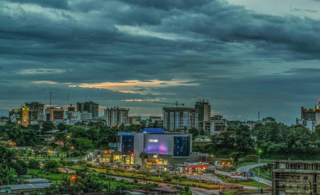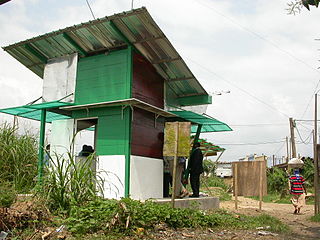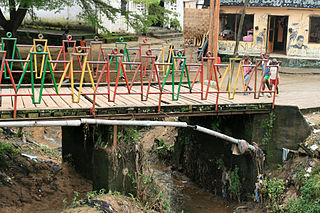L'arbre à palabres is a permanent sculpture located in Douala (Cameroon). Created by the architecte Frédéric Keiff in 2007, it looks like a palaver tree, whose trunk and branches are made of painted iron rods, while attached fragments of colored glass represent leaves.

Sculpture is the branch of the visual arts that operates in three dimensions. It is one of the plastic arts. Durable sculptural processes originally used carving and modelling, in stone, metal, ceramics, wood and other materials but, since Modernism, there has been an almost complete freedom of materials and process. A wide variety of materials may be worked by removal such as carving, assembled by welding or modelling, or molded or cast.

Douala is the largest city in Cameroon and its economic capital. It is also the capital of Cameroon's Littoral Region. Home to Central Africa's largest port and its major international airport, Douala International Airport (DLA), it is the commercial and economic capital of Cameroon and the entire CEMAC region comprising Gabon, Congo, Chad, Equatorial Guinea, Central African Republic and Cameroon. Consequently, it handles most of the country's major exports, such as oil, cocoa and coffee, timber, metals and fruits. As from 2018, the city and its surrounding area had an estimated population of 1,338,082. The city sits on the estuary of Wouri River and its climate is tropical.

Cameroon, officially the Republic of Cameroon, is a country in Central Africa. It is bordered by Nigeria to the west and north; Chad to the northeast; the Central African Republic to the east; and Equatorial Guinea, Gabon and the Republic of the Congo to the south. Cameroon's coastline lies on the Bight of Biafra, part of the Gulf of Guinea and the Atlantic Ocean. Although Cameroon is not an ECOWAS member state, it geographically and historically is in West Africa with the Southern Cameroons which now form her Northwest and Southwest Regions having a strong West African history. The country is sometimes identified as West African and other times as Central African due to its strategic position at the crossroads between West and Central Africa.
Contents
| L'arbre à palabres de Bonambappe | |
|---|---|
 | |
| Artist | Frédéric Keiff |
| Year | 2007 |
| Type | Sculpture |
| Dimensions | 5 m(200 in) |
| Location | Jardin du tombeau des Rois Bell, Bonanjo Douala, Cameroon |
| 4°02′38″N9°41′14″E / 4.043768°N 9.687152°E Coordinates: 4°02′38″N9°41′14″E / 4.043768°N 9.687152°E | |
| Owner | Municipality of Douala |


















